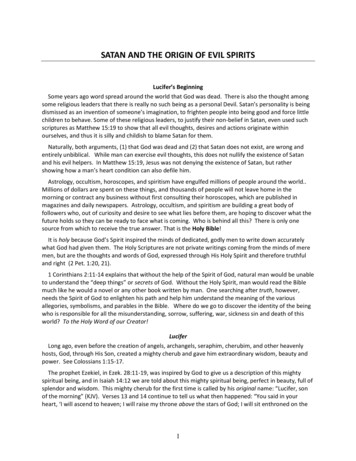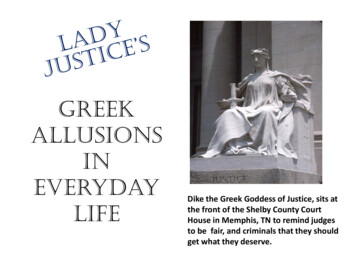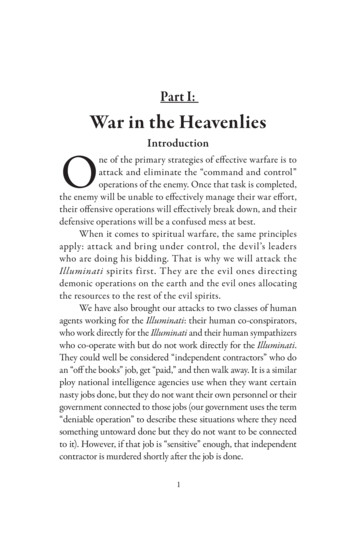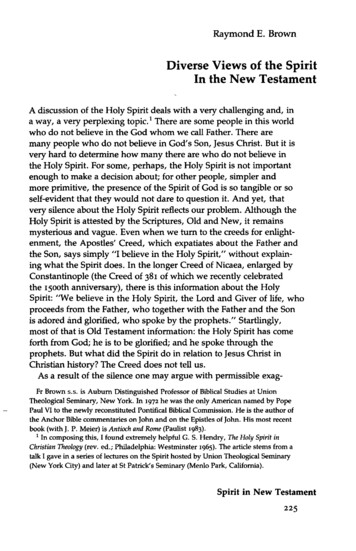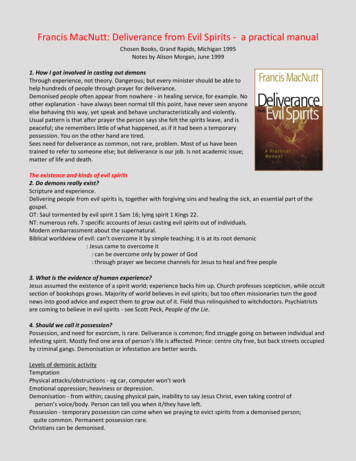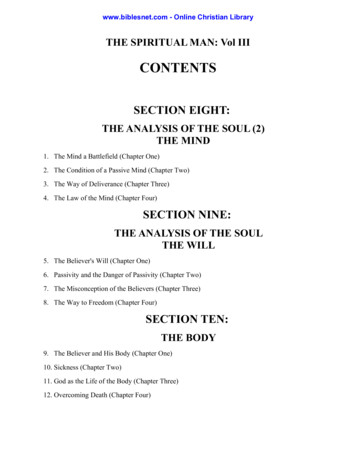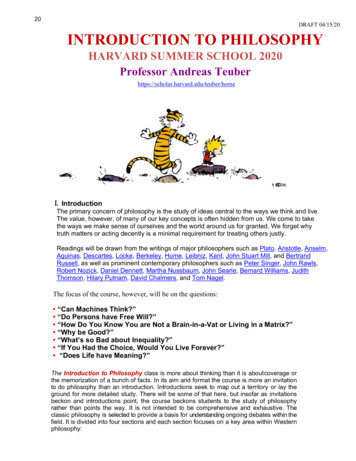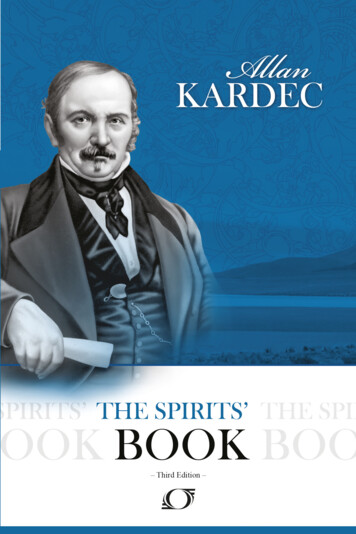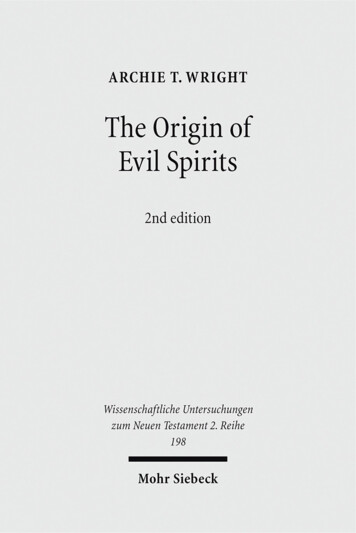
Transcription
Wissenschaftliche Untersuchungenzum Neuen Testament · 2. ReiheHerausgeber / EditorJörg Frey (Zürich)Mitherausgeber / Associate EditorsMarkus Bockmuehl (Oxford)James A. Kelhoffer (Uppsala)Hans-Josef Klauck (Chicago, IL)Tobias Nicklas (Regensburg)198
Archie T. WrightThe Origin of Evil SpiritsThe Reception of Genesis 6:1– 4in Early Jewish LiteratureSecond, revised editionMohr Siebeck
Archie T. Wright, born 1958; PhD, University of Durham; Associate Professor of BiblicalStudies at Regent University, Virginia, USA.ISBN 978-3-16-151031-1 / eISBN 978-3-16-157496-2 unveränderte eBook-Ausgabe 2019ISSN 0340-9570 (Wissenschaftliche Untersuchungen zum Neuen Testament, 2. Reihe)The Deutsche Nationalbibliothek lists this publication in the Deutsche Nationalbibliographie; detailed bibliographic data are available on the Internet at http://dnb.dnb.de. 2013 by Mohr Siebeck, Tübingen. www.mohr.deThis book may not be reproduced, in whole or in part, in any form (beyond that permitted bycopyright law) without the publisher’s written permission. This applies particularly to reproductions, translations, microfilms and storage and processing in electronic systems.The book was printed by Laupp & Göbel in Nehren on non-aging paper and bound by Buchbinderei Nädele in Nehren.Printed in Germany.
Table of ContentsPreface to the Second, Revised Edition . IXPreface to the First Edition . XIAbbreviations.X VIChapter 1Introduction . 11.1 The Problem . 11.2 The Approach . 31.2.1 Structure of the Thesis . 31.2 Argument and Scope of the Present Study . 51.4 Summary . 9Chapter 21 Enoch 1–36: The Book of Watchers: A Review of Recent Research . 112.1 Introduction . 112.2 History of the Texts . 122.3 Structure of the Book of Watchers . 132.4 Summary of the Content of the Book of Watchers . 162.5 Focus of the Research . 19Excursus: Notable terms in the Book of Watchers . 20Watchers . 20Shemihazah . 21Azazel/Asa’el . 21Giants . 22Nephilim . 222.6 Date, Place, and Authorship of the Book of Watchers . 23Excursus: Job 4 and the Dating of Job and the Watcher Tradition . 292.7 Source Critical Approach to the Book of Watchers . 332.7.1 Milik . 292.7.2 Kvanvig . 302.7.3 Collins . 312.7.4 Hanson . 322.7.5 Nickelsburg . 332.7.6 Newsom . 34
VITable of Contents2.7.8 Dimant . 352.8 The Function of the Book of Watchers . 372.8.1 Nickelsburg . 382.8.2 Hanson . 412.8.3 Newsom . 422.8.4 Collins . 442.8.5 Suter . 462.9 Conclusion . 47Chapter 3Strategies of Interpreting Genesis 6:1–4 . 513.1 Introduction . 513.2 Interpreting the Passage – Genesis 6.1–4 . 543.2.1 Verse 1 . 553.2.2 Verse 2 . 61Excursus: The Greek “Sons of the Gods” . 733.2.3 Verse 3 . 763.2.4 Verse 4 . 803.2.4.1 Nephilim . 813.2.4.2 Gibborim . 843.3 Conclusion . 903.3.1 Verse 6.1 . 933.3.2 Verse 6.2 . 933.3.3 Verse 6.3 . 943.3.4 Verse 6.4 . 943.3.5 Summary . 95Chapter 4Reception of the “Sons of God” in the Book of Watchers . 974.1 Introduction . 974.2 Tradition of the Bene Elohim . 984.2.1 Bene Elohim as the Watchers . 1004.2.2 Bene Elohim as the Angels of the Nations . 1024.2.3 Bene Elohim as the Host of Heaven . 1034.3 The Asa’el/Instruction tradition . 1054.3.1 Asa’el versus Azazel . 1084.3.1.1 Origin of the Name of Asa’el . 1084.3.2 Asa’el and the Atonement Motif . 1114.3.3 Asa’el and the Prometheus Myth . 1164.3.4 Summary of the Instruction/Asa’el Tradition . 1194.4 The Shemihazah Tradition . 1204.4.1 Who is Shemihazah? . 121
Table of ContentsVII4.4.1.1 Origin of the Name of Shemihazah . 1224.4.2 Shemihazah’s Role in the Instruction tradition . 1254.4.3 Shemihazah Tradition and the “Origin of Evil” . 130Excursus: Marriage in Genesis 6.2 . 1354.5 Conclusion . 139Chapter 5The Rebellion Motif in the Book of Watchers . 1415.1 Introduction . 1415.2 Rebellion of the Angels . 1415.3 Interpreting the Consequences . 1465.3.1 The Corruption of the Earth . 1475.3.2 The Judgment of the Watchers . 1485.4 The Nature of the Gibborim . 1495.5 Aetiology of Evil Spirits . 154Excursus: Mastema and Belial . 1605.6 A Developing Anthropology . 1635.6.1 Spirit in the Biblical Tradition . 1645.7 Giantology Versus Anthropology . 1665.8 Conclusion . 168Chapter 6Reception of the Watcher Tradition in the Dead Sea Scrolls. 1696.1 Introduction . 169Excursus: Dualism in Relevant Qumran Fragments . 1701QS–Rule of the Community . 1711QHa – Thanksgiving Hymns . 1734QAmram–Visions of Amram . 17311Q11(Apocryphal Psalms) . 1744Q510 and 511 – Songs of the Maskil . 174CD – Damascus Document . 17511Q5 Column 19 – Plea for Deliverance . 175Summary . 1766.2 Incorporation of a Dualistic Worldview . 1776.3 Demonic Possession in the DSS . 1816.4 Prayer at Qumran . 1836.4.1 11Q11 (11QPsAp a): Invoking the Divine Name . 1846.4.2 11Q5 (11QPsa) Column XIX: Plea for Deliverance . 1886.4.3 4Q510 and 4Q511: Songs of the Maskil . 1906.5 Conclusion . 193
VIIITable of ContentsChapter 7Philo of Alexandria: Interpreting Genesis 6:1–4 . 1947.1 Introduction . 1947.2 Philo of Alexandria: Exegete or Philosopher? . 1957.2.1 Philo’s Audience . 1987.2.2 Problems of Interpretation . 2007.3 Philo’s View of the Soul . 2027.3.1 The Immortality of the Soul . 2057.4 De Gigantibus: Philo’s Giantology and Anthropology . 2097.4.1 Angels and Daemons . 2137.4.2 Philo’s “Giantology” . 2167.5 Conclusion . 218Chapter 8Results and Conclusions . 223Bibliography . 227Biblical Material . 227Texts and Translations of Primary Texts . 227Other Reference Material Consulted . 230Secondary Sources . 231Index. 245
Preface to the Second EditionThis monograph is a second revised edition to the revision of my doctoralthesis, “Breaching the Cosmic Order: The Biblical Tradition of Genesis6:1–4 and its Reception in Early Enochic and Philonic Judaism.” Thethesis was submitted to the Faculty of Theology at the University ofDurham in February 2004. I am very grateful to Dr. Jörg Frey and Dr.Henning Ziebritzki for their initial interest in my topic and the subsequentapproval for the WUNT 2 series. What follows in the volume is a minorrevision of the initial publication by Mohr Siebeck.While undertaking the revision of the manuscript I took seriously thereviews/critiques prepared in various journals by the following individuals(in alphabetical order): Paul J. Brown, Philip R. Davies, David InstoneBrewer, T. Klutz, Grant Macaskill, Mark D. Owens, Finny Philip, PaoloSacchi, and Sean Winter. Each of these scholars offered very helpfulcomments that I am certain would improve the content and argumentpresented in the volume. However, due to time limitations, I was unable toaddress all of the issues in the revision, but I do plan to address thosedeemed significant in future essays or a complete rewrite of the presentvolume. Nevertheless, one or two comments should be made concerningthe interpretation of the Watcher Tradition that seemed to be a concern ofnearly all the reviewers. First, it was not my intention to suggest that theso-called “origin of evil spirits” was the only interpretation one couldcome up with when reading the Book of Watchers. There are certainlyothers including George Nickelsburg’s connection to the Wars of theDiadochi or to the corruption of the Temple priesthood. Second, I mustalso affirm the comments of Paulo Sacchi and Philip Davies that I mayhave overemphasized the role of Genesis 6:1–4 in the development of theBook of Watchers (i.e. underemphasized the role of other possiblesources); however, if Genesis 6:1–4 is not the source for the author of theBook of Watchers, then both authors must have had access to the sametradition if one considers the parallels between Genesis chapter 6 and 1Enoch chapter 6.I would like to thank each of the reviewers for their very helpfulcomments and I look forward to further interaction with them.Archie T. WrightNorfolk, Virginia, 2013
PrefaceThis monograph is a revision of my doctoral thesis, “Breaching the CosmicOrder: The Biblical Tradition of Genesis 6:1-4 and its Reception in EarlyEnochic and Philonic Judaism.” The thesis was submitted to the Faculty ofTheology at the University of Durham in February 2004. I am very gratefulto Dr. Jörg Frey and Dr. Henning Ziebritzki for their initial interest in mytopic and the subsequent approval for the WUNT 2 series. I appreciatetheir editorial suggestions, which have no doubt improved the quality ofthe work. I would especially like to thank Tanja Mix for her patience andtremendous assistance in bringing the manuscript to completion.Most who have attempted to complete a Ph.D. will say that it is one ofthe loneliest tasks that a person can experience. In part, this is true.However, a Ph.D. is never the work of a single individual, but it involvesthe efforts a special group of people in the student’s life. Thus, a gratefulacknowledgement for the academic, spiritual, financial, and emotionalsupport must be given, although one cannot express enough gratitude inthese few lines. For me, this list of people could produce many pages, so Imust limit my heartfelt thanks to a special group of individuals.I offer a great many thanks to Ken and Lenore Mullican who have beena source of inspiration and encouragement during the process and in theyears prior to moving to Durham. They have shown their loving friendshipthrough prayer and financial support. Many thanks go to Kenny andStephanie Mullican whose friendship, prayer, and financial support havebeen invaluable. The same must be said of Chad and Debbie Cox, FelipeOrnelas, and Dr. John Swails. I must also give special thanks to long-timefriends Scott and Kathy Rex and Janet Koons for their support and prayers.I also must single out my brother Tom for his encouragement and financialsupport. All my family deserves especial merit for their encouragementand support throughout the process.Of course, there are many in Durham who have been especially helpful.Thanks to all at St. John’s College, college officers, staff, and studentswho have made Durham a home away from home. Special thanks must begiven to Brad and Kori Embry. They have been true friends. The samemust be said for Ron and Kathy Herms and their four beautiful children(Annaliese, Jaeden, Adrienne, and Avrielle). Finally, I must thank MarkBonnington for being a good friend and always an encourager.Prior to taking up a place at Durham, I had heard many nightmarishstories about Ph.D. supervisors and all the difficulties that come with that
XIIPrefacerelationship. However, I can give only praise to my two supervisors,Professor Loren T. Stuckenbruck and Professor C.T. Robert Hayward.Both have shown why they are experts in their field. The knowledge theyhave given, the direction they have offered, and the patience they haveshown, made working with them a memorable experience. Most of all theyhave offered a hand of friendship that I hope will continue in the yearsahead. Special thanks must also be given to the faculty of the Abbey Housefor their valuable insight and to the staff for their administrative support.I am grateful to all who have assisted in reading and offeringsuggestions to the drafts of the thesis and eventually the book. However, Itake full responsibility for the content of this work.Finally, I must thank the Lord for the calling and ministry that he hasplaced on my life. Without His wisdom and spiritual guidance, none of thiswould have been possible. I pray this work will bring light and knowledgeto the Kingdom.Archie T. WrightDurham, England 2005
AbbreviationsABABDANETANRWAnt.b.1 SCDC.E.cf.ch(s).1, 2 Chrcol(s).ConBNT1, 2 r BibleAnchor Bible DictionaryAncient Near Eastern Texts Relating to the Old TestamentAufstieg und Niedergang der römischen WeltJosephus, Jewish AntiquitiesBabylonian Talmud1 BaruchBefore Common EraFrancis Brown, S. R. Driver, and C. A. Briggs, The NewBrown – Driver – Briggs – Gesenius Hebrew and English Lexicon with anAppendix Containing the Biblical Aramaic. Peabody, MA.: Hendrickson,1979BerakotBereshithBiblica et OrientaliaBrown Judaica StudiesBiblische NotizenBulletin of the School of Oriental and African StudiesBook of Watcherscenturycirca, aboutCatholic Bible QuarterlyCatholic Bible Quarterly Monograph SeriesCairo Genizah Damascus DocumentCommon Eracomparechapter(s)1. 2 Chroniclescolumn(s)Coniectanea Biblica: New Testament1, 2 CorinthiansCompendia rerum iudaicarum ad Novum TestamentumCorpus scriptorium Christianorum coveries in the Judean DesertDictionary of New Testament Background: A Compendium ofContemporary Biblical ScholarshipDead Sea DiscoveriesDead Sea ScrollsEcclesiastes
XIVed(s).1 EnEth.ExodExp RHUCAibid.idemIEJIsaJBLJdtJerJJSJNESJos. JTSJubJudgJ.W.1, 2 KgsLABLAELamLCLAbbreviationseditor(s), edition1 EnochEthiopicExodusExpository enesisHabakkukHaggaiHebrew BibleHomer, IliadHomer, OdysseyHoseaHarvard Studies in Classical PhilologyHarvard Theological ReviewHebrew Union College Annualin the same place as the previous citation(s)the same authorIsrael Exploration JournalIsaiahJournal of Biblical LiteratureJudithJeremiahJournal of Jewish StudiesJournal of Near Eastern StudiesJoseph and AsenethJoshuaJournal for the Study of Judaism in the Persian, Hellenistic, and RomanPeriodsJournal for the Study of Judaism SupplementsJournal for the Study of the New TestamentJournal for the Study of the New Testament SupplementsJournal for the Study of the Old TestamentJournal for the Study of the Old Testament SupplementsJournal of the Study of the PseudepigraphaJournal of the Study of the Pseudepigrapha Supplemental SeriesJournal of Semitic StudiesJournal of Theological StudiesJubileesJudgesJosephus, Jewish War1, 2 KingsLiber antiquitatum biblicarum (Pseudo-Philo)Life of Adam and EveLamentationsLoeb Classical Library
AbbreviationsLevLeviticusLkLukeLXXSeptuagint (Greek O.T.)m.Mishnah1, 2, 3 Macc1, 2, 3 MTMasoretic Text of the O.T.n.noteNahNahumNid.NiddahNovTNovum TestamentumN.T.New TestamentNTTNorsk Teologisk TidsskriftNumNumbersO.T.Old TestamentOTPOld Testament Pseudepigrapha, Charlesworth EditionOTSOudtestamentische StudiënPesahiimPesahiPGPatrologia GraecaPhilo of AlexandriaAbr.De AbrahamoAgr.De AgriculturaCher.De CherubimConf.De Confusione LinguarumCongr.De CongressuContempl.De vita contemplativaDecal.De DecalogoDet.Quod DeteriusDeus.Quod Deus immutabilis sitEbr.De EbrietateFug.De Fuga et InventioneGig.De GigantibusHer.Quis Rerum Divinarum HeresHypoth.HypotheticaIos.De IosephoLeg.1, 2, 3Legum allegoriae I, II, IIILegat.De Legatione ad GaiumMigr.De Migratione AbrahamiMos. 1, 2De vita Mosis I, IIMut.De Mutatione NominumOpif.De Opificio MundiPlant.De PlantationePost.De Posteritate CainiPraem.De Praemiis et PoenisQEQuaestiones et Solutiones in ExodumQGQuaestiones et Solutiones in GenesinSacr.De Sacrificiis Abelis et CainiXV
XVISobr.Somn.Spec.Virt.PREProvPs(s)Ps. Sol.PVTGRab.RBrepr.RevQ1, 2 SamSanh.2TPSBLDSSBLSPSib. Or.SirSJLASTDJSusT. SolT12PT. AsherT. BenjaminT. DanT. GadT. IssacharT. JosephT. JudahT. LeviT. NaphtaliT. ReubenT. SimeonT. ZebulunTDNTTg(s).1, 2 viationsDe SobrietateDe SomniisDe Specialibus LegibusDe VirtutibusPirke Rabbi EliezerProverbsPsalm(s)Psalms of SolomonPseudepigrapha Veteris Testamenti GraeceRabbahRevue bibliquereprintedRevue de Qumran1, 2 SamuelSanhedrinSecond Temple PeriodSociety of Biblical Literature Dissertation SeriesSociety of Biblical Literature Seminar PapersSibylline OraclesSirachStudies in Judaism in Late AntiquityStudies on the Texts of the Desert of JudahSusannaTestament of SolomonTestaments of the Twelve PatriarchsTestament of AsherTestament of BenjaminTestament of DanTestament of GadTestament of IssacharTestament of JosephTestament of JudahTestament of LeviTestament of NaphtaliTestament of RuebenTestament of SimeonTestament of ZebulunTheological Dictionary of the New TestamentTargum(s)1, 2 ThessaloniansTobitTheological Studiesvolume(s)Supplements to Vetus TestamentumWisdom of SolomonWissenschaftliche Monographien zum Alten und Neuen TestamentWissenschaftliche Untersuchungen zum Neuen TestamentZeitschrift für die alttestamentliche WissenschaftZechariahZephaniah
Chapter 1Introduction1.1 The ProblemThe research presented here is concerned with the reception history ofGenesis 6.1–4 in early Enochic and Philonic Judaism during the SecondTemple Period (hereafter, 2TP). I suggest that the non-specificity inherentin the biblical text of Genesis 6.1–4 opened the basis for the lateremergence of an aetiology of evil spirits as Jewish authors engaged withthe text. As a result, Genesis 6.1–4, particularly its interpretation in 1Enoch 6–16, played an important part in the development of demonologyduring the 2TP.Accordingly, by the turn of the Common Era there was in place aworldview within Judaism in which the activity of autonomous or semiautonomous evil spirits was regarded as a reality. This view is exemplifiedin the ministry of Jesus as described in the Synoptic Gospels of the NewTestament. By contrast, there is little evidence in Jewish literature duringthe earlier biblical period for such evil spirits. The understanding ofdemonic affliction found in the Jewish Scriptures (both Hebrew and Greektraditions) does not contain any references to autonomous or semiautonomous evil spirits that are able to afflict humanity at will. When theyare mentioned in the Hebrew Bible (hereafter HB), evil spirits are seen asbeings sent by God to accomplish God’s plan in the lives of individualsand the nation of Israel (see e.g. Num 5.14–15, 30 – spirit of jealousy; 1Kgs 19.7, Isa 37.7 – lying spirits; Hos 5.4 – spirit of whoredom; Judg 9.23,Job 4.12–16 – spirits in the service of God; 1 Sam 16.14–23; 18.10–12;19.9–10 – evil spirit upon Saul). The LXX translates various Hebrewterms1 related to some type of wild beast that lurks about in the night or inthe wilderness as a demonic creature. 21There are just twenty-one occurrences in the LXX of the term daimo&nion (dai/mwn),with all but one outside the Pentateuch (Deut. 32:17). The Hebrew term translated demon inthe LXX varies: yc (daimo&nia, Isa 34.14; 13.21 – desert creature); ry(# (daimo&nia [Isa13.21 – hairy goat], also o)nokentau&rioj [Isa 34.14, 13.21], matai/oij [Lev 17.7 – goatdemon], and ei0dw&loij [2 Chr 11.15 – satyrs]); d# (daimoni/oij, Deut 32.17, Ps 106(105).37, 38 – demon). All English translations are from NASV.2See Edwin Yamauchi, “Magic or Miracle? Diseases, Demons and Exorcism,” inGospel Review: The Miracles of Jesus (ed. David Wenham and Craig Blomberg;
2Chapter 1This raises the question of how the presence of categorically evil spiritscould have emerged in the writings of the first century C.E. Since nomaterial comparable to an episode such as, for example, Mark 5.1–20exists in the HB, we must look elsewhere. 3 It is in this search that weencounter the Book of Watchers (1 En 1–36 BW). This third-centuryB.C.E. pseudepigraphic composite work offers the oldest extant record ofthe origin of evil spirits in Judaism (see ch. 2 for question of the date of thedocument). As suggested above, the non-specificity inherent in Genesis6.1–4 provided the authors of BW the opportunity and the biblicalauthority, to further develop a demonology in the 2TP. Such a view issubstantiated through an examination of the continued development of thetradition around the turn of the era. In what follows, this study will attemptto reveal how the reception of Genesis 6.1–4 encouraged the developmentof the demonology and anthropology in the 2TP. I will endeavour toascertain what Jews of the 2TP understood with regard to the origin andactivity of evil spirits by examining the development of the concept of evilspirits alongside a developing understanding of human nature(anthropology) in early Jewish literature. Along with BW, I will addressthe interpretation of Genesis 6.1–4 in the Book of Jubilees, the treatises ofPhilo of Alexandria, and other Pseudepigrapha for any insights they mightoffer. In addition, I will discuss the taking up of the concept of evil spiritsfrom the Watcher tradition by the authors of the Dead Sea Scrolls. Each ofthese texts sheds a particular light on the investigation and reflectssignificant developments of demonology and anthropology in this period.The enigmatic nature of these sources requires an introductory caveat.One must resist approaching these sources in an attempt to find clear pathsthrough the traditions. Clarity of this type is obfuscated by inherentcomplexities. Rather, it is fitting to offer plausible stages of developmentin the various documents. The historical disparity between the varioussources only serves to validate this approach, which may offer a betterview of the developing Jewish understanding of the origin of evil. Thesestages of growth may have merged to make possible the diversity of theSheffield: JSOT, 1986), 89–183. Yamauchi argues that the demonology in Israel isrestrained in comparison to Mesopotamia. See Edward Langton, Essentials ofDemonology: A Study of Jewish and Christian Doctrine, Its Origin and Development(London: Epworth, 1949). Langton contends that restraint in respect of the Babylonianand Assyrian influences was due to the desire “to affirm the belief in Yahweh as the o netrue God.” This restraint, he argues, is the reason for the lack of references todemonology among the early Hebrews.3For the most recent examination of demonic activity in the New Testament, see EricSorensen, Possession and Exorcism in the New Testament and Early Christianity(WUNT 157; Leiden: Mohr Siebeck, 2002).
Introduction3tradition of demonic affliction encountered in the New Testament. AndyReimer maintains:In this task of reconstructing demonologies, one must seek to hold a tension between anintegrated and consistent reading of a text or body of texts and an awareness of thesociology of knowledge ‘gaps’ in any religious sect’s worldview. The history ofdemonology has certainly shown that attempts by texts such as 1 Enoch to rationalizeentities that are by definition chaotic, irrational and typically open to all out specu lationare bound to fail. Scholarly attempts to reconstruct any sort of ancient demonology willalways have to work in the midst of chaos. 4Reimer is correct in his assertion that the demonology of 1 Enoch is indeedchaotic. However, it may be possible that we can ease the sense of chaosby examining the matter of demons and evil spirits alongside a rather lesschaotic anthropology, which was emerging in the 2TP at the same time asan interest in demons, was becoming apparent.1.2 The ApproachI will attempt to unpack what can only be described as a very complicatedcollection of traditions that serve as the background of the “Watchertradition” in BW. In an effort to trace the develo
Book of Watchers (i.e. underemphasized the role of other possible sources); however, if Genesis 6:1–4 is not the source for the author of the Book of Watchers, then both authors must have had access to the same tradition if one considers the p


